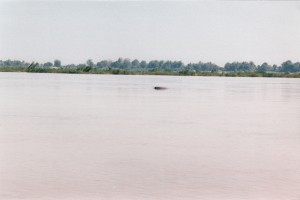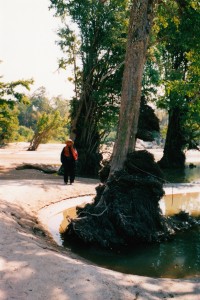[In January 2003 I accompanied an expedition that was conducting a survey of river dolphins on a stretch of the Mekong River in Cambodia. The expedition was led by Isabel Beasley, who was then a PhD student specializing on Orcaella brevirostris: also known as the ‘Irrawaddy Dolphin’ this species is found in many Asian river systems and deltas. The journal I kept during the expedition will appear on this site as a continuous series of posts. This is part 17 of the series.]
Isabel hopes to do these surveys continuously over a year. After that she will have a complete and fairly exhaustive record of where the dolphins live and where and how this is connected to changes in the seasons etc. She’s concerned for example that she’s missing some animals in the Jan, Feb, March period. At this time dolphins are still moving outside the deepwater pools. She can tell that many of them are away, because a comparison of sighting-numbers and estimates shows that a number of them are missing and unaccounted for at this time. She simply does not know where they are – they could be ranging quite far afield or they could be just on the outskirts of the pools. There is no clear way of determining this. I suggested that they might be in the tributaries but she explained that this wasn’t possible as the water is too low. Accounting for these unaccounted animals might well be one of the major contributions of her thesis.
 Another contribution will be in resolving the question of why dolphins choose some pools and not others as favoured habitats. There are literally hundreds of deep water habitats that are not used by the dolphins. Her feeling is that the dimensions of the pools make a difference – depth certainly does because they don’t like pools that are too deep. The depth has to be just right. But the connection between the pools and the main channel of the river also makes a difference: they prefer pools that are not too isolated; there have to be easy connections to other similar pools.
Another contribution will be in resolving the question of why dolphins choose some pools and not others as favoured habitats. There are literally hundreds of deep water habitats that are not used by the dolphins. Her feeling is that the dimensions of the pools make a difference – depth certainly does because they don’t like pools that are too deep. The depth has to be just right. But the connection between the pools and the main channel of the river also makes a difference: they prefer pools that are not too isolated; there have to be easy connections to other similar pools.
 The pools at Kampi and Chray Banteay are a good example of this – they are on two different sides of the river, but there are channels connecting them, so the dolphins can move back and forth. The topography might also make a difference. She has a feeling that they like gentle, curving slopes – not steep channels. When she gets back to write up she intends to spend a lot of time figuring out the geomorphology of the river pools.
The pools at Kampi and Chray Banteay are a good example of this – they are on two different sides of the river, but there are channels connecting them, so the dolphins can move back and forth. The topography might also make a difference. She has a feeling that they like gentle, curving slopes – not steep channels. When she gets back to write up she intends to spend a lot of time figuring out the geomorphology of the river pools.
At the moment her work focuses on three things: one is Abundance (determining the numbers); the second is distribution (habitat preferences); the third is critical habitats. The third aspect is particularly important to the conservation aspect of her work – and this is very important to her; all her zoological work has a conservation aspect to it.
I asked Isabel: What would you do if you were to make a field trip to the Sundarbans to study the Gangetic dolphin? Her answer was that she would first do a preliminary survey. For this she would hire a local boat. What kind of boat? I asked. Ideally, she said, she would like a boat that provided a raised viewing platform. I asked why she hadn’t got a boat of that kind for this survey and she said it wouldn’t have been possible because big boats couldn’t negotiate the Mekong’s rapids and would certainly not be able to make it all the way to Stung Treng. It struck me that a similar issue would arise in the Sundarbans, for a big boat wouldn’t be able to make it into the smaller creeks.
However she added that platform height was not an important factor in direct counts (like that which she’d do in the Sundarbans). The important thing was to keep the same platform height throughout.
The next thing she’d do is conduct interviews with local people, in order to get an idea of distribution, habitat preferences etc. After that she would design a survey to suit the local conditions.
